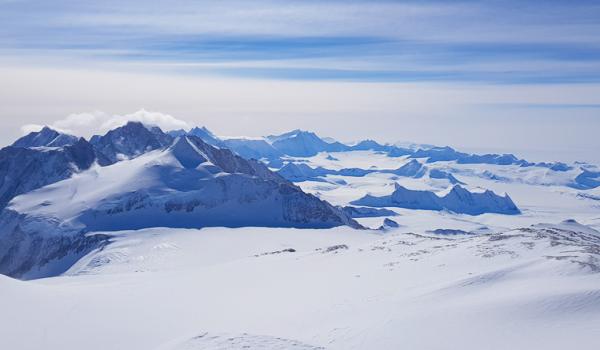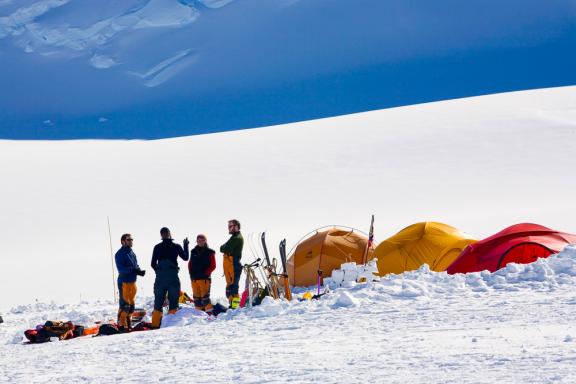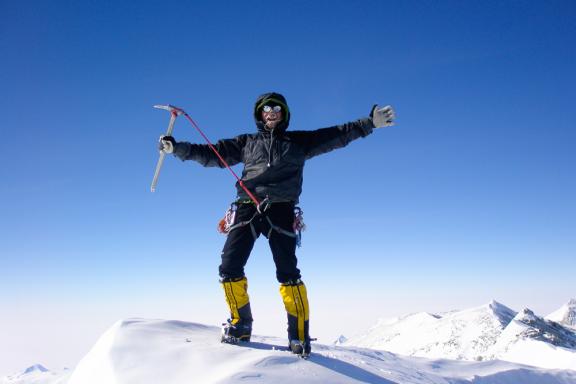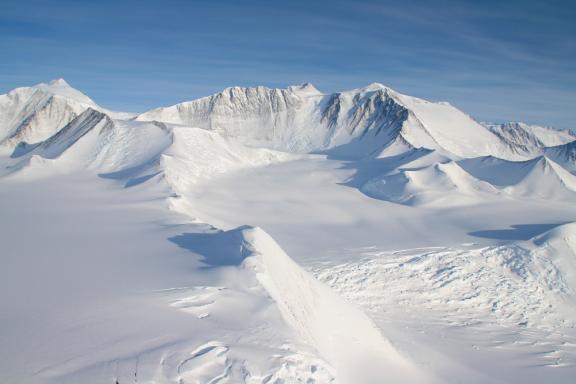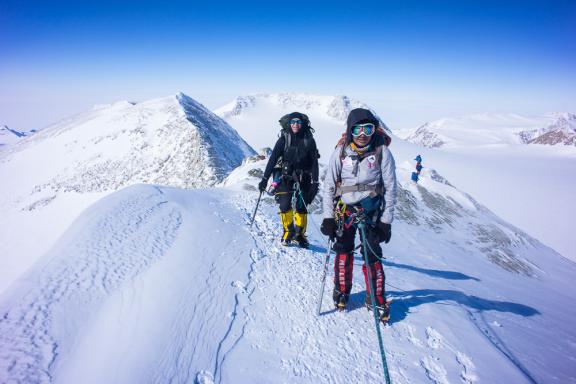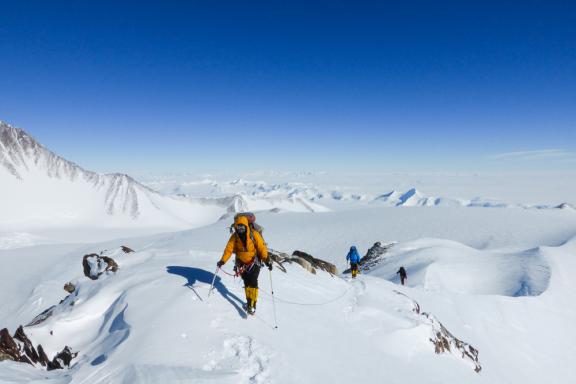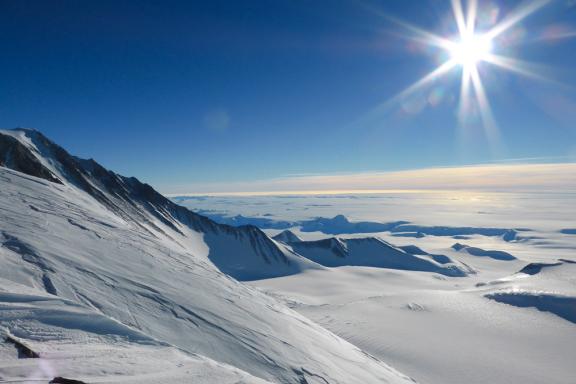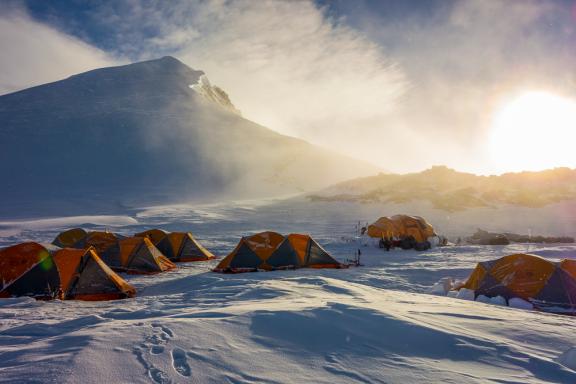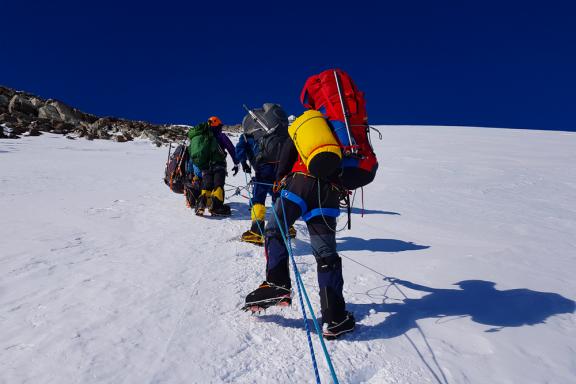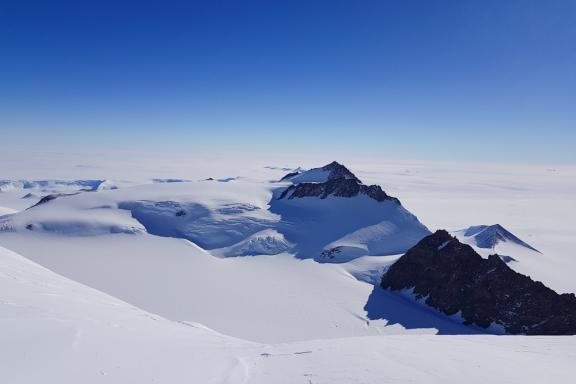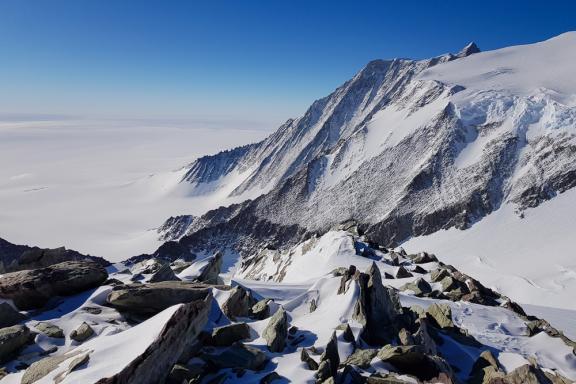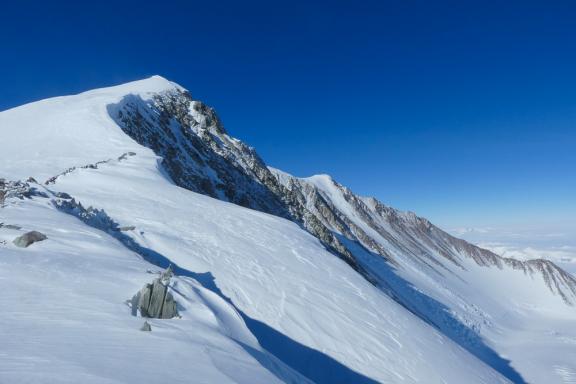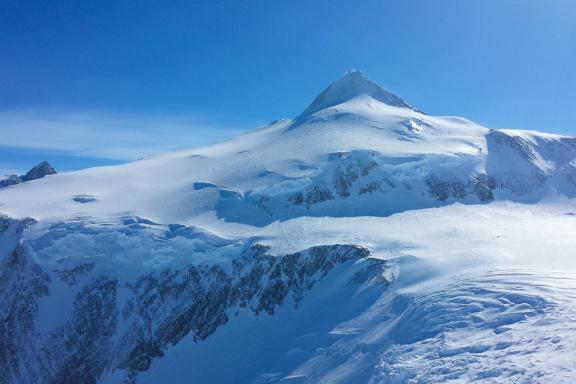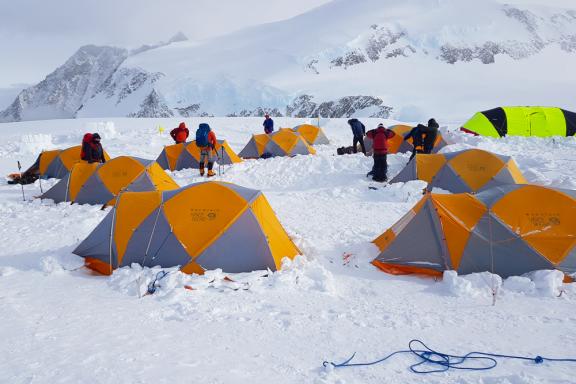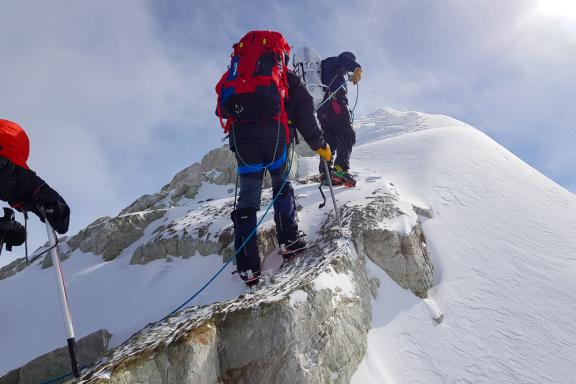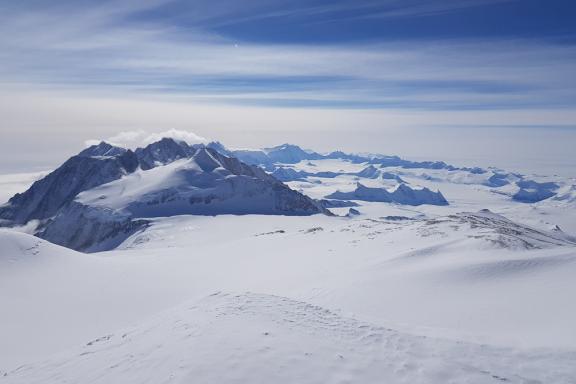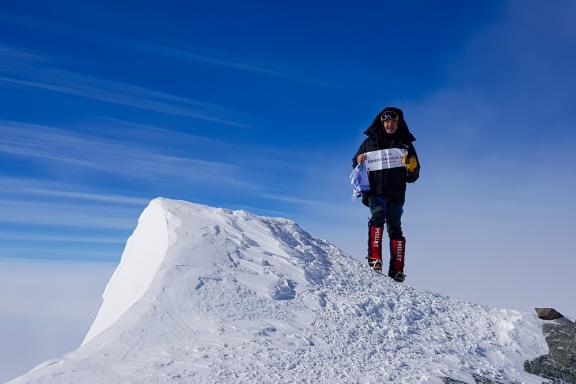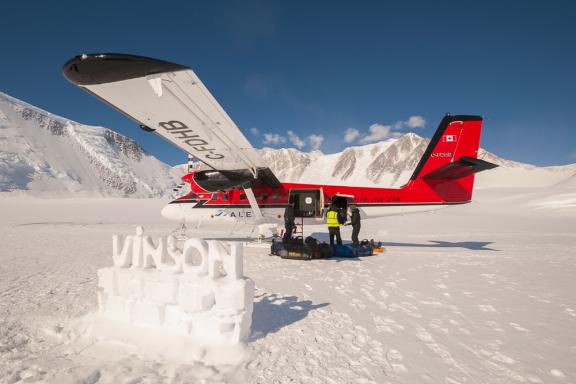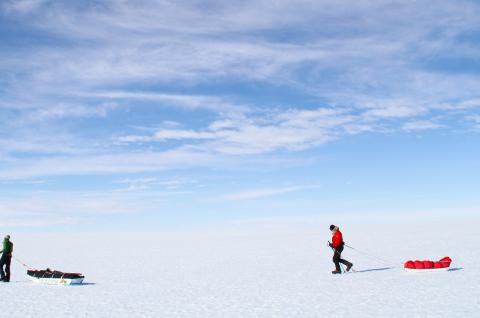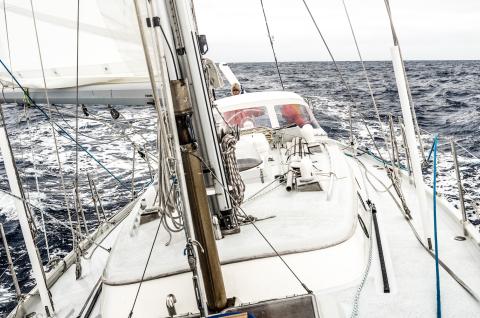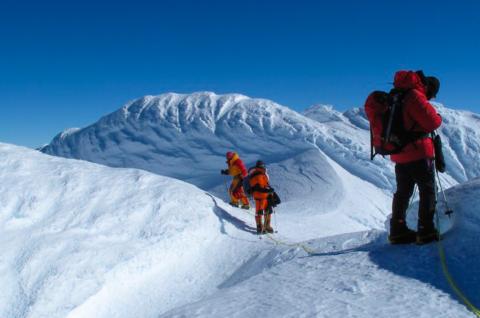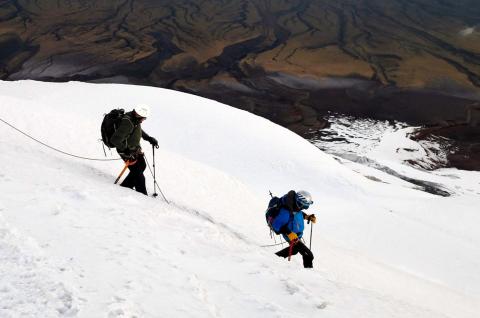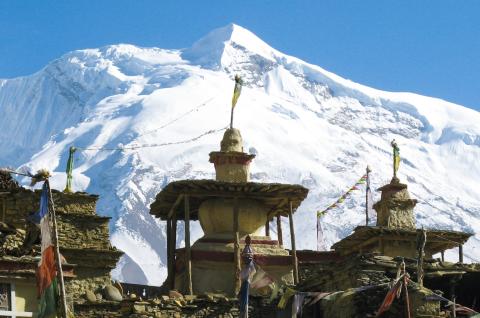The "Seven Summit" of Antarctica
Highlights
- Climbing Antarctica's highest peak
- Breathtaking ice and snow landscapes
- Highly experienced English-speaking polar guide
- Personalized follow-up of your preparation included
- H24 medical hotline during your expedition
- Live expedition coverage for your community
- A human adventure beyond the physical challenge
Mount Vinson at 4892 meters is the highest peak in Antarctica and one of the coveted Seven Summits. Majestic, snow-capped peaks protect vast glaciers below and in the distance, snow meets the sky along a sharply curved horizon. All of the challenges you have had to overcome to get this far only enhance the expanse of beauty you are looking at and the sense of accomplishment that comes from achieving the extraordinary. You climb the Branscomb Shoulder Route, which has become the “standard route”, scaling beautiful glaciers, 40° snow-covered slopes, an exposed high plateau and a spectacular summit ridge. The pace of the climb and the daily progression plan are set by your experienced English-speaking guide, and are geared to the safety and success of your ascent. Mount Vinson is a mountain unlike any other, in one of the most remote regions on the planet.
Overview
Mount Vinson lies in the Ellsworth mountain range, judiciously named the Sentinel Massif, in the heart of Antarctica. The first conquest of the summit took place on December 18, 1966, and for many years there was no second ascent due to its extreme remoteness and difficult access.
In 1985, our partner ALE pioneered logistical support for a private expedition to Mount Vinson, and just over thirty years later, its teams continue to guide climbers to the bottom of the world!
It is one of the 7 Summits imagined by Dick Bass and Franck Wells in 1985. These summits are Everest (8848 m) from the Nepalese south side or the Tibetan north side for Asia, Aconcagua (6962 m) in Argentina for South America, Mount Denali (6190 m), formerly Mac Kinley in Alaska for North America, Kilimanjaro (5895 m) in Tanzania for Africa, Elbrus (5646 m) in Russia for Europe, Mount Vinson (4892 m) in Antarctica and the Carstensz Pyramid (4884 m) or Puncak Jaya in Indonesian Papua for Oceania. The Seven Summits challenge involves climbing the highest peak on each of the seven continents. We chose Messner's list, which favors Elbrus over Mont Blanc and the Carstensz Pyramid over Kosciuszko. According to www.7summits.com, there were just over 400 climbers who had achieved this by the end of 2016. Add the North and South Poles, and the challenge is called the Grand Slam.Expeditions Unlimited can help you complete it.
Despite its relatively low altitude, climbing Mount Vinson is by no means a formality and should not be underestimated.
On the one hand, Mount Vinson's altitude of 4892 meters at these particularly low latitudes, due to the lower atmospheric pressure at the poles, can be compared to a pressure altitude of around 5500 meters at the equator, with the corollary effects on hypoxia. And on the other hand, the summit plateau, even in the austral summer, can be subject to winds that will be able to drop the temperature below -30°C.
Discover our animated itinerary for the ascent of Mount Vinson.
Itinerary
Days 1 & 3: Europe – Punta Arenas
Day 1
We arrive at Punta Arenas in Chilean Patagonia. On arrival at the airport, we are met by our partner ALE. We are then driven to our hotel. During these two days, we check our equipment with our guides. We are also invited to a welcome dinner.
Day 4: Bag preparation and safety briefing
Day 4
This morning, the ALE team heads back to our hotel to collect our bags, which will be pre-charged to the plane. The rest of the day is free, and at the end of the day we are invited to a welcome aperitif and safety briefing. We are given a briefing on boarding, the weather and how to get to Union Glacier.
Day 5: Flight to Antarctica
Day 5
Loading of equipment and boarding for Union Glacier. This flight is subject to the vagaries of Antarctic weather and runway conditions. The flight from Punta Arenas will take 4 to 5 hours. After a few hours' flight, we pass the Antarctic Circle and see our first icebergs! An hour before landing, we put on our polar clothing in preparation for the landing.
We are welcomed at the camp at 700 meters altitude and then fly to the Vinson Base Camp.Vinson Base Camp is situated at an elevation of 7021 ft (2140 m) on the Branscomb Glacier and offers a spectacular setting to relax and recover from our travel to Antarctica, while we prepare for the climb ahead. Here we meet our guides, who will accompany us on our ascent. On the first day, our guide will take our team on a short acclimatization treck which allows us to familiarize with the Antarctic environment and refine our clothing and equipment choices for the climb.
We keep the team sizes small so our guides can assess individual strengths and challenges for each team member to develop a strategy that maximizes everyone’s chance for a successful ascent. The following day, we pack our personal equipment as well as a small amount of food and fuel.
Days 6 & 7: Vinson base camp
Day 6
Your team will ascend Vinson using the Branscomb Shoulder Route (standard route). The climb usually takes 5-9 days depending on weather conditions and how quickly team members acclimatize. Most groups set two intermediate camps on the mountain prior to attempting the summit. Our climb is a team effort and at the end of each day, everyone takes part in setting up the camp. The rate of ascent and the daily progression plan are defined by your guide to ensure everyone’s safety and success. We are all roped together throughout our progress up the mountain due to hazards that come with crevasses.
Days 8 & 9 : From Base Camp (2140 m) to Low Camp (2780 m)
Day 8
From Vinson Base Camp, we follow the gradual rise of the Branscomb Glacier to Low Camp (9,121 ft/2780 m). This gentle climb is ideal for pulling sleds, allowing you to lighten your pack load. Typically, climbers split their 40-49 lb (18-22 kg) loads by carrying 30% in a backpack and 70% on a sled when they leave Base Camp. The climb to Low Camp takes 4-6 hours and ascends 2,100 ft (640 m) where a large dining tent and cached sleeping tents await for our first night on the mountain. Low Camp is in the shade until the late morning and it is normal for people to stay in bed until the sun hits the tents. After a late breakfast, our guide leads us on an excursion to a nearby viewpoint and we take the opportunity to train and familiarize ourselves with the equipment. Fit groups will be able to climb Pic Knutzen (3373 m), a 5-6 hour round trip from Low Camp...
Day 10: From Low Camp (2780 m) to High Camp (3780 m)
Day 10
When conditions are suitable and the forecast indicates stable weather ahead, our team leaves the sleds at Low Camp and ascend to High Camp (12,402 ft/3780 m) carrying all the equipment in backpacks. Low Camp to High Camp is 3,281 ft (1000 m) of elevation gain and usually takes groups 6-8 hours to complete. The route takes us up the broad mixed spur at the northern end of Branscomb Ridge, offering fantastic views of Mount Shinn and the glaciers below. The trek to the start of the fixed ropes takes less than 1 hour. We ascend fixed ropes on snow covered slopes up to 45°. Snow conditions can vary from soft to hard and wind-blown with icy patches. The ascent of the fixed ropes takes approximately 4-5 hours. There is a large ledge at the half-way point where we can stop for a rest and enjoy some food and drink. The trek from the top of the fixed lines to High Camp takes about 1.5 hours, ascending the gentle slopes of the summit glacier. This final section of the route can be very exposed to the wind, requiring care to prevent cold injury. The facilities at High Camp are more basic than those at Low Camp. Our guide prepares simple meals in a cooking shelter and we can eat inside our tent or outside if the weather is calm. The next day is normally spent resting and acclimatizing at High Camp to give everyone the best chance of summiting.
Days 11 & 12 : From High Camp (3780 m) to Summit (4892 m)
Day 11
We aim to reach the summit on a day with the best possible weather conditions, good visibility and light winds. The positive difference in altitude between High Camp and the summit of Mount Vinson is 1112 meters, and the round trip is 9 to 12 hours for most groups. Most of the route follows the gently sloping valley of the Vinson summit, with a short, steeper slope of snow and ice leading to the spectacular, rocky summit ridge. Parts of the route are exposed and may be subject to strong winds. The summit pyramid can be climbed by two routes. The easiest access is via the left (east) ridge, which is less steep than the right (west) ridge. Many teams cross the summit by ascending from the right and descending from the left. Our guide chooses the most appropriate route according to weather conditions and the group's ability. The panorama from the summit is breathtaking. Mounts Gardner, Tyree, Epperly and Shinn dominate the foreground, surrounded by impressive peaks rising from the vast ice cap below. Here, at the summit of Antarctica, the true scale and majesty of the continent is overwhelmingly apparent. We take time to take photos and savor the experience before returning to High Camp.
Day 13 : Descent To Base Camp
Day 13
The descent to Vinson Base Camp usually takes one day from High Camp, re-tracing your route down the fixed ropes and along the Branscomb Glacier. At Base Camp we celebrate our summit with a hearty celebration meal and a toast to the team!
Days 14 & 15 : Return to Union Glacier
Day 14
Vinson Base Camp will stay in close contact with Union Glacier Camp to identify the best "weather window" for our return flight. Depending on flights, we may have at least one day at the end of our expedition to explore more of Union Glacier. We enjoy a hot shower and celebrate our summit with our team! Here we receive a certificate to commemorate our Mount Vinson expedition.
Day 16: Return flight to Punta Arenas
Day 16
As soon as the weather permits, we load our gear and take off for Punta Arenas, where our team welcomes us and transfers us to the hotel.
Days 17 & 18: Return flight to Europe
Day 17
After breakfast, depending on the plane's departure time, we have some free time to enjoy Punta Arenas a little more. Then our minibus picks us up to take us to the airport. Flight to Europe. Landing on day 17.
END OF EXPEDITION
For reasons that cannot be foreseen at this stage, such as unpredictable weather, the physical fitness or lack of fitness of participants or other circumstancess (customs formalities, road conditions, traffic, landslides, force majeure, etc.), your expedition leader may have to adapt the program, if necessary, to ensure the smooth running of your trip. He remains the sole judge and the one who guarantees your safety. Activity times are given as an indication and may vary from one participant to another.
The itinerary for all our expedition programs, or the ascent program for our high-mountain expeditions, are given here as a guide only. They are flexible enough to adapt to weather conditions with a few contingency days. In any case, you should follow the recommendations of your guide, who may suggest that you cancel your expedition due to weather, safety or physical conditions.
It is important to remember that this is a truly unsupported expedition, and that anything can happen. Expeditions Unlimited, your expedition leader, your guide or our local teams can in no way be held responsible.
Any costs incurred as a result of a change in the expedition schedule (extra nights' accommodation, extra flights) will be borne by the participants and not by the organizers. "Contingency days" refer to the expedition in the strict sense of the term (base camp/base camp in the mountains, departure point/exit point on a traverse, etc.).
Any early return of the expedition or of certain members only (early success, abandonment, etc.), generating costs for accommodation, meals, changes to air tickets or other activities not provided for in this program, will be charged in full to the participants.
Trip notes
Guiding
On this expedition, you will be guided by an English-speaking mountain guide, experienced in both mountain and polar environments. He will help you set up camps and carry equipment from base camp.However, you are responsible for carrying your own personal belongings and equipment.
The pace of the climb and the daily progression plan are set by your guide, and are geared to the safety and success of your expedition.
For unpredictable reasons at this stage, like adverse weather conditions, insufficient physical condition of participants, insufficient competencies of participants related to the intended activities, your guide may decide to adjust the intended program and/or activities. At all times, his decision will be final on all matters likely to affect the safety and well-being of the trip.
Difficulty level
Level rated: difficult
This program is aimed at participants in good physical shape, with a significant sport practice, endurance in particular, holding a strong mental to face difficulties that are unforeseen by nature.
This expedition requires significant mountaineering experience and active hiking, trekking or mountaineering to be as self-sufficient as possible. You need to be able to progress with your own rope party or roped up with your guide, and to know how to handle ropes. You have to carry some gear, initially divided between the pulka and the rucksack, from base camp to Low Camp. As mentioned above, you need to allow for around twenty kilos, of which 30% should be in the rucksack and 70% in the sled. From Low Camp to High Camp, the rucksack should weigh less than 15 kg.
The altitude of 4892 meters on Mount Vinson at these particularly low latitudes, due to the lower atmospheric pressure at the poles, can be compared to a pressure altitude of around 5500 meters at the equator, with the corollary effects of hypoxia.
Weather conditions can also deteriorate, and even at the time of this expedition, i.e. during the austral summer, temperatures can become very negative, from -20°C to -30°C, or even lower, particularly on the summit plateau, where -40°C can be reached.
All in all, good physical and mental preparation is essential, given the hostile environment (remoteness, cold, bad weather, discomfort), as well as medical preparation to optimize your chances of success. Team spirit is also essential. Each participant is responsible for applying safety rules, looking after his or her own equipment and maintenance, setting up camp and preparing meals. As always in this type of project, the key to success is teamwork and team spirit.
As a reminder, the language of the expedition is English, so a basic knowledge of Shakespeare's language is essential.
Participation in the preparation days is strongly recommended. You will also be asked to provide an expedition/trekking/athletic CV for each participant, enabling us to measure the participant's ability to successfully complete the project with a high probability. Under 65, no medical certificate is required. Preparatory mountaineering courses at our École de l'Aventure can be a great asset, both for building confidence and for gaining autonomy.
Technical difficulty
Mountaineering level: PD like... A little difficult (Peu Difficile in French)
In this program, the use of mountaineering equipment (crampons, harness, ice ax, ropes, etc.) is necessary and the route tackled may involve small difficulties, whether it is a little more inclined during glacier mountaineering, height of the walls, the length and the continuity of the efforts. It is therefore aimed at rough beginners who already have a little experience in mountaineering, who have already completed a few ascents of this level or slightly below. The mountaineering courses at our Adventure School from three days are for you. And this technical rating applies of course to normal weather conditions: the difficulty can increase in the event of bad conditions, fresh snow on rocks, insufficient or lack of quality of ice , etc. Likewise, the situation changes radically, for the same technical level, with the altitude, the weight of the bag, the lack of equipment on the route, the fatigue associated with the approach if it is long, the environment, if particularly hostile, etc.
Compagnies aériennes internationales
We leave with ALE from Punta Arenas and then from Union Glacier. They take care of the logistics, which account for over 80% of the total cost of this expedition. If international flights are not included in the price, we can book them for you free of charge. Scheduled airlines to Punta Arenas include Aerolíneas Argentinas, Iberia, Air France, Lufthansa, etc.
We have chosen ALE to handle the air logistics, so it's also with ALE that you contract for these logistics. You must therefore sign all their documents (registration form; medical form; liability waiver) and accept their general and special conditions of sale, as well as proving that you have repatriation and health insurance. We can of course assist you in providing these documents.
Accommodations
We can provide you with a list of hotels in Punta Arenas for booking purposes. We can also make reservations on your behalf. Then, from Base Camp, in North Face VE25 double expedition tents. A kitchen crew will be permanently installed at Base Camp and Low Camp.
Meals
Full board throughout the expedition, except in Punta Arenas. During the expedition, meals are prepared by the cook from imported products up to Low Camp. Afterwards, we eat freeze-dried rations to ensure the best nutritional/weight/weight ratio.These rations include coffee and tea, cereals, mashed potatoes, soups, broths, Chinese noodles, freeze-dried dishes, snacks, etc. in space-saving vacuum-packs.
Transfers / Transport
Transfers to and from the airport, and to and from the expedition starting point, are provided by minibus by our local teams.
Group size
The group is composed of 1 to 12 participants maximum. The number of participants is deliberately limited to allow for greater immersion, to avoid embarrassing our hosts, and to develop freedom and flexibility. However, the maximum number may be exceeded if the last person to register wishes to travel with one or more other people. The services will not be modified, and the conditions of the trip will remain the same.
Equipment
Personal equipment is not provided. However, a complete list is provided to allow you to check that you are taking what is necessary.
All logistics equipment is provided.
All logistical equipment is provided, including individual tents, dining tents, gas heating for the evenings, shower and toilet tents, as well as all collective and individual cooking equipment, stoves and more. Your support team will have a satellite phone to keep in touch with the outside world, as well as communication and safety equipment, a geolocation beacon, etc. The camps are permanently linked by radio. Expeditions Unlimited will also provide you with an Iridium telephone to enable you to contact us at any time, for technical or medical reasons. Other personal equipment is not provided. A complete list is given below, and will be added to during our expedition preparation meetings.
Our commitments to sustainable development
Our commitment to a better planet has been a reality since the beginning of our story but we always need to do more and better. Please find out more about our charter and our commitments in terms of sustainable development. We have drafted our charter and take action through six themes on which we act as concretely as possible, most often with you: social equity and cultural respect, preservation of water, waste management in expedition, protection of biodiversity, raise public awareness on these subjects and finally, the optimization and recovery of CO2 emissions.
Regarding carbon emissions, most of which are due to air travel, we calculated and communicated in 2018 on the carbon footprint of each of our programs, expressed in tonnes of CO2.
And in 2022, we have set ourselves a carbon reduction target that we believe is unprecedented in the tourism industry, aiming to reduce the total emissions of our activity by 5% per year, taking 2019 as the reference year (3,430 tonnes of CO2). This commitment is in line with the trajectory of the Paris climate agreements of 2015, the current benchmark. By 2030, we aim to not exceed 2,160 tons of CO2. In 2024, all Secret Planet journeys emitted 2,064 tons, well below our maximum limit of 2,940 tons. The ceiling for 2025 is 2,800 tons, and in 2026 it will be further reduced to 2,660 tons. And so on until 2030. To find out more about all of our calculations and our commitments in terms of reducing our carbon emissions.
In addition, since 2019, we have been encouraging you when you book for your journey to contribute with a donation to an independent NGO, among the two we have selected that share the commitments made in our charter. We matched the amount of this donation to this program's carbon footprint. Thus, the journey you are considering generates 7,08 tons of CO2, which corresponds to a 100% donation of €212 for an estimated value today of €30 per tonne of CO2. This donation remains of course optional and you can decide to give between nothing and 100% of this amount. Since 2019, including covid years of 2020 and 2021, we have been able to collect thanks to you nearly €5,500 for these associations.
Please do not hesitate to come back to us with any questions you might have regarding this carbon footprint mechanism, our other sustainable développement commitments or even to share with us your experience through a chat or a mail at contact@secret-planet.com.
Departures and pricing
Please find below all dates and prices for this expedition. Prices are quoted "from" and may be adjusted notably according to the number of participants (see trip notes for details). Please note that dates and prices for years beyond 2024, when given, are for guidance only and are subject to change and readjustment to take account of current economic realities.
No date works for me!
I initiate a new datePrice includes
- Return flights from Punta Arenas to Union Glacier.
- 25 kilos baggage allowance plus one piece of cabin baggage measuring no more than (46cm x 41cm x 26cm) between Punta Arenas and Union Glacier.
- Return flight from Union Glacier to Vinson Base Camp.
- Welcome dinner on arrival in Punta Arenas and celebration dinner at Union Glacier.
- Airport/hotel transfers in Punta Arenas.
- Full-board meals during the expedition.
- Base camp food supply.
- Base camp equipment: fully equipped kitchen tent, mess tent for meals, toilet tent, table and chairs.
- Cooks and helpers at Union Glacier and Vinson base camp.
- Tents for two, freeze-dried food, stoves and fuel.
- English-speaking mountain guide with extensive polar experience.
- Collective equipment required for the ascent (fixed ropes, moorings).
- Specific individual equipment required for the expedition (pulka, harness).
- Personal satellite phone with one hour's free telecommunications.
- Taxes and permits for ascents, rights of way for fixed ropes and other government taxes.
- Medical follow-up by Ifremmont during the expedition (see above).
- Preparation days in France (practical, medical).
- Live coverage of the expedition for your community (supply of InReach beacon, IridiumGo and subscriptions, configuration of LivExplorer service).
Price does not include
- International flight to/from Punta Arenas.
- Hotel accommodation and full board in Punta Arenas.
- Consular fees (visa).
- Excess luggage over the 25-kilo allowance between Punta Arenas and Union Glacier is charged at US$75/kg.
- Customs taxes on arrival in Chile.
- Import taxes for satellite phones, professional communications equipment and commercial filming.
- Expenses related to shifts in the expedition schedule (additional nights' accommodation, air supplements).
- Expenses related to the early return of the expedition or of certain members only (early success, abandonment, etc.), generating costs for accommodation, meals, changes to air tickets or other activities not included in this program.
- Tips for the guide, to be shared with other participants to your satisfaction.
- Hotel nights, full board and other personal expenses during preparation days in France (practical, medical).
- Pre-acclimatization protocol developed with Ifremmont and Sport Altitude (personalization, advice, follow-up, equipment) as described above.
- Personal equipment, including high-altitude gear and fleece.
- Drinks and all personal expenses (personal visits, cabs, souvenirs, dry cleaning, etc.).
- Travel and expedition insurance (assistance, evacuation and repatriation).
Your custom expedition
We put our expertise, our knowledge of the terrain, our creativity, our experience, the quality of our guides and the reliability of our partners at your service to build your custom expedition. We can also personalize an expedition to your wishes as soon as you form a "closed" group, whatever the number of participants.
This means that, unless you authorize us to do otherwise, no outside participants join you, and we can personalize your expedition by adapting it to your own pace, with the program extensions you desire, a higher level of comfort, certain activities, other encounters, etc.
Every expedition of this type is subject to a specific quotation. To get in touch with us now, please fill in the short questionnaire below. One of our experts will get back to you to refine your request and make you a proposal.
